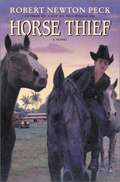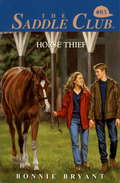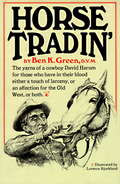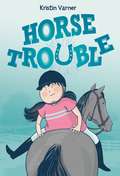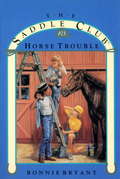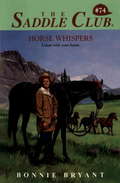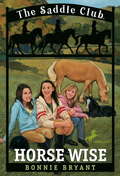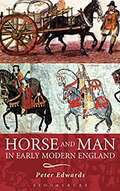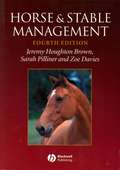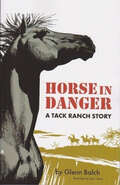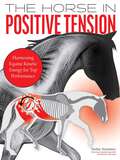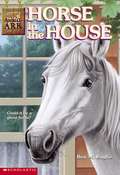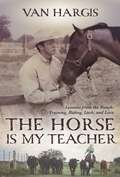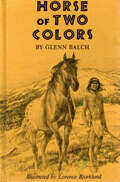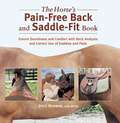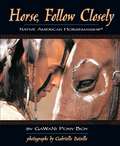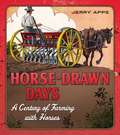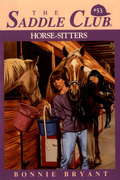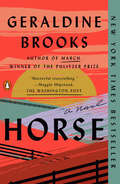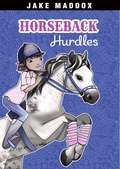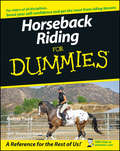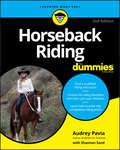- Table View
- List View
Horse Thief
by Robert Newton PeckAfter losing two fingers in his first bull ride, seventeen-year-old Tullis Yoder worries he'll never have a chance to top another bull. Then the rodeo show he works for goes broke, and he learns that its thirteen horses, his only family, will be slaughtered for dog meat. With the help of a lady doctor and an aging professional horse thief, Tullis steals his beloved horses. He wants to set the horses free, but with crooks, three sheriffs, and a powerful judge after him, will he have a chance?
Horse Thief (Saddle Club #83)
by Bonnie BryantThe Saddle Club is taking part in a big Pony Club rally being held at Pine Hollow. Riders from all the local Pony Clubs are there, including Stevie's boyfriend, Phil Marsten. For once Stevie and Phil aren't being too competitive so everyone is having a good time--until a thief spoils the fun by stealing $500 from the stable office. Veronica diAngelo says she saw Phil hanging around the office and acting suspiciously. And Phil did need money. But he'd never resort to theft, would he? Is Veronica up to something? Or is there a thief among the riders? It's up to the Saddle Club to find out and clear Phil's name.
Horse Tradin'
by Ben K. GreenHere are the yarns of a true cowboy for those who have in their blood either a touch of larceny, an affection for the Old West, or better yet, both. These twenty tales add up to a true account of Ben K. Green's experiences around the corrals, livery stables, and wagon yards of the West. Green was a veterinarian who took down his shingle and went into horse trading, in what he imagined would be retirement. No stranger to the saddle, Green claims to have "with these bloodshot eyes and gnarled hands measured over seventy thousand horses. " His tales range from tricks to make an old horse seem young (at least until the poor creature died from the side effects of the scam) to a recipe for making a dapple-gray mule from a bucket of paint and a chicken's egg. So you want to go into the horse business? You can learn the knavery, skill, salesmanship, and pure con man hokum of horse trading here, in a book every westerner or horse fancier should have on hand. Copyright © Libri GmbH. All rights reserved.
Horse Training In-Hand
by Ellen Schuthof-Lesmeister Kip MistralWorking the horse from the ground—schooling in-hand as it has been known for centuries—has long been an integral part of classical horse training. Now, this gorgeously illustrated book explains in clear, step-by-step lessons how the modern-day horse owner can incorporate classical groundwork in her daily interactions with her equine partner—to both their benefit and enjoyment.Whether schooling green or young horses; retraining problem horses or those with poor foundations; warming-up advanced mounts prior to workouts; confirming lateral movements on the ground before attempting them on horseback; or supplementing everyday under-saddle exercises, work in-hand provides a wonderful way to advance the horse's education, as well as the standard of communication between horse and handler. Its gradual progression of work on the longe, double-longe, long lines, short reins, and long reins is the perfect addition to the training program that has grown a little stale or boring; the manageable solution to countless problems that commonly arise in daily work with horses; and by definition, an equestrian art form unto itself.With over 100 color photographs—including many detailed series shots—to demonstrate correct body positioning, and meticulously hand-drawn illustrations to guide you through the often-confusing land of lateral work,Horse Training In-Handis the first bookeverto help shed classical groundwork's mystique while conscientiously preserving its magic. Find out for yourself how schooling in-hand can give your training program a brand new look and feel, forever transforming workouts and schooling sessions into artistic endeavors that yield breathtaking results.
Horse Trouble
by Kristin VarnerAn American Library Association 2021 Best Graphic Novel for ChildrenTwelve-year-old Kate is laser-focused on her one true passion: horseback riding. But try as she might, she can't hide from life's problems in the stable.There's nothing Kate loves more than being around horses. But her best friend is allergic to them, so Kate has to take riding lessons without her. Kate's forced to navigate some of life's hardships—like the mean girls at the stable who tease her and her body insecurities—all on her own. To make matters worse, Kate is continually falling off her horse. To Kate, her tween years feel like one unfair punishment after another. Can she get over it all…and get back on her horse?Horse Trouble, the debut graphic novel from children's book artist Kristin Varner, is an oh-so-relatable graphic novel with humor and heart.
Horse Trouble (Saddle Club #23)
by Bonnie BryantWhen Mrs. Reg, the manager of Pine Hollow Stables, goes away for a few days, The Saddle Club is determined to pitch in and keep things running smoothly. Lisa, Carole, and Stevie decide they know everything there is to know about horses, so they'll have no problem managing a stable for a few days...right? Wrong! instead it seems that every time the girls try to help, disaster quickly follows. More paint winds up on one of the horses than on the stable; several riders don't get quite the ride they expect; and Mrs. Reg's paperwork is in utter chaos. Soon the members of The Saddle Club are wondering if being horse crazy is all they need to manage the stable, after all!
Horse Whispers (Saddle Club #74)
by Bonnie BryantThe Saddle Club finds her running with a herd of wild horses that lives on the Bar None land. They bring the mare back. She runs away again. They bring her back again, only to have her run away once more.
Horse Wise (Saddle Club #11)
by Bonnie BryantWHEN MAX ANNOUNCES that Pine Hollow will begin its own Pony Club, Stevie, Carole, and Lisa are excited to know they're about to become even more knowledgeable about horses. But spoiled Veronica is more focused on riding her new horse than learning how to take care of him. The Saddle Club won't soon forget what happened with Veronica's last horse, Cobalt. And when it looks like she's headed for the same trouble again, the girls are quick to act--but are they already too late?
Horse Wise: Thinking Outside the Stall and Other Lessons I Learned from My Horse
by Cheryl KimballHorses teach life's great lessons--keep it simple/ learn to think differently/ lead by respect, not dominance/ consider the horse's (other person's) perspective. Horse Wise is full of horse sense and human common sense. Horsewoman and author Cheryl Kimball uses endearing real-life stories of working with horses to tell readers what her horses have taught her about managing a company, being a leader for employees in times of trouble, and how to live everyday life more deeply and authentically.Among the many valuable lessons horses have taught Kimball over the years are:* Learn to Control Your Anger* Leadership is an Important Thing* The Importance of Consistency* Don't Force Things* Be HumbleReaders don't need a horse to apply the life lessons of Horse Wise. Sharing stories from her horse world, Kimball explains how the lessons learned from the horse apply to the world of people and our relationships with each other--and ourselves.Funny and poignant stories show readers that when we put ourselves in a horse's shoes, we gain compassion and wisdom--and we get what we need.
Horse and Man in Early Modern England
by Peter EdwardsHorses were used for many purposes in Shakespeare's England: for travel, either on horseback or in carriages, for haulage and for pleasure, and for work in the fields. The upper classes were closely involved with horses, for jousting, hunting and racing. Horses was also essential to any army, both as cavalry and to draw supplies and artillery. Horse ownership was, however, much more widespread than might be imagined. <p><p> Horse and Man in Early Modern England shows how, in pre-industrial England, horses were bred and trained, what they ate, how much they were worth, how long they lived, and what their owners thought of them. <p><p> While they were named individually, and sometimes became favourites, many were worked hard and poorly treated, leading to their early deaths. They were, nevertheless an essential part of the life of the time and are strikingly depicted in literature and art, as well in many other records.
Horse and Stable Management
by Sarah Pilliner Zoe Davies Jeremy Houghton BrownSince the first edition was published in 1984 Horse and Stable Management has become the recognised source of reliable information on all aspects of the practical management of horses and ponies. It is now the established textbook for everyone who owns a horse or works with horses. This fourth edition has been radically revised and reorganised to include the most up-to-date and accurate procedures and advice. With many new photographs, Horse and Stable Management includes chapters covering evolution and behaviour, conformation and action, routine preventive measures, nursing the sick horse, first aid, lameness and the management of breeding stock. Horse and Stable Management is essential reading for those taking British Horse Society and Association of British Riding Schools examinations as well as those taking college equine courses or National Vocational Qualifications in horse care and management. The Authors Jeremy Houghton Brown was manager of the British National Equestrian Centre and the British Racing School, then for many years principal lecturer in equine studies at Warwickshire College, where he started and pioneered British equine education. Above all, he is an experienced, practical horseman. Sarah Pilliner is an equine consultant specialising in horse care. She is also an experienced lecturer, competition rider, senior examiner, and the author of several books. Zoe Davies is a former lecturer in equine science, a consultant equine nutritionist, author and external examiner for higher education courses. She has substantial experience in equine management and training. From previous reviews: ‘A new classic… a clearly written and easily understood handbook.’ Riding ‘It is extremely comprehensive. It is also accurate. In fact, a most valuable book for anyone who owns a horse.’ Horse and Hound ‘The approach and contents are refreshingly different… very informative and a valuable source of reference.’ Horse and Rider
Horse by Nature
by Mary Ann SimondsThe first complete reference to help equestrians make the changes needed to ensure social license and the ability to ride and compete horses for years to come. Renowned wild horse ecologist and equine behaviorist Mary Ann Simonds provides a practical soup-to-nuts manual for understanding how horses think, feel, learn, communicate, and interact with each other and with humans. Integrating over 30 years of field research, identifying functional social behaviors in wild horses with her lifelong professional practice working with equestrians solving equine behavioral issues, Simonds helps readers gain a strong foundation into the emotional and cognitive lives of horses and explore various horse-human relationships. She provides numerous tools for assessing personalities, communicating with horses, and understanding how horses learn, with an emphasis on improving care and reducing stress in competitions and sports. In three parts, each introduced by top researchers and scientists in the equestrian field, readers will: LEARN the natural history and social ecology of free-roaming wild horses. UNDERSTAND the instincts, learned behaviors, gender differences, social roles, and social bonds that are the driving factors in horse culture. DISCOVER how adaptable horses really are, and how that makes them an ideal species to share their social lives with humans. FOCUS on horse-human relationships applying the knowledge from Part One to reduce equine stress and improve communication in the management and training of all horses. EXPLORE how to better assess the horse&’s personality and emotions, understand his learning style, and use various communication channels to establish trust, improve friendship, and enhance performance. ADDRESS the ethics of horse sports and ask the questions needed to ensure horse welfare in all the disciplines. CONSIDER dozens of changes related to horse management and competition recommended by respected industry professionals. BE EMPOWERED to be an influencer to improve the lives of horses, whatever the profession, breed, or sport. Filled with hundreds of color-coded tips and beautiful photos, and backed by science, personal stories, and unique insights, readers have multiple ways to quickly find useful information and apply it to their own horse-human situations. Whether preparing for a horse show, working with young stock, riding on the trails, adopting a wild horse, running a rescue, or just hoping to improve your communication and relationships with all horses, this book is a catalyst for much-needed change in the equine industry.
Horse in Danger: A Tack Ranch Story (Tack Ranch #7)
by Glenn BalchTwo men from nearby Bar-B rode in to Tack Ranch in an angry mood. They accused King, the black stallion, of raiding their brood mares. And, if Vince Darby didn't do something about it-since King carried his brand-they'd have to shoot. King was the leader of the largest band of wild horses that roamed the wild and rugged Twin Buttes country. He was more than just a horse to Ben and Dixie Darby and to Gaucho, the Argentine trainer who had such a way with horses. King was a leader and a fine herd sire, so they had to prove, if possible, that he had not raided the ranchers' herds. What happens in the big rugged ranch country of Idaho and Nevada when these three Tack riders start out to look for the missing colts makes a fast-moving and exciting mystery, written with the same fine understanding for horses that all of the many readers of Glenn Balch's books have come to expect.
Horse in Positive Tension
by Stefan StammerAn illustrated study of the biomechanics of horse-and-rider movement like no other. Everything you know about riding and the horse&’s movement isn&’t what you think it is! Did you know that: • On a functional level, traditional ways of teaching rider position and horse movement do not actually work with the biomechanical system that is horse and rider? • Use of the inside rein does not encourage the horse to bend to the inside? • Training exercises and lessons that claim to be simple cannot be as easily applied as it might seem? In these pages, physical therapist and equine movement specialist Stefan Stammer uses a startlingly unique collection of color illustrations to make movement patterns in the horse visible to the human eye, in order to help riders better understand the principles of energy and motion happening within the horse. By forming new mental images for the rider, Stammer&’s goal is to profoundly impact the rider&’s daily work with her horse so that it is harder for her to make common mistakes or interfere with the horse&’s natural mechanisms. With his hind end as his engine, the horse generates kinetic energy (the energy his body possesses due to its motion). For optimal movement and performance, this energy should flow through the horse&’s body to the horse&’s mouth, where it is fine-tuned with the rein aids before cycling back to the hind end. However, this movement flow is often unintentionally disrupted on its way through the horse by the rider. When, however, the cycle of kinetic energy within the horse is supported through the correct understanding and application of biomechanics—the mechanical laws relating to his and his rider&’s movement and structure—the outer shape of horse and rider together achieve &“positive tension.&” This is the rhythmic stimulation of all the neuromuscular functions necessary to perform harmoniously and at peak ability. Most importantly, once the rider understands the basic principles of the biomechanics of a horse in movement, her &“feeling&” in the saddle will improve. Better &“feel&” is an integral building block for the small and subtle steps of progress, which should accompany a rider for her entire life with horses. This smart, fascinatingly composed book is for any horseperson looking to limit riding and training mistakes, grow an understanding of how the horse best functions, and optimize equineability and performance.
Horse in the House (Animal Ark #26)
by Ben M. BaglioMandy and James are sad that their friend Wilfred Bennett has to sell his riding stables. Things get even worse when Sam Western turns the land into a campsite and wants everyone to forget that the stables ever existed.
Horse is My Teacher
by Van HargisStories from a rural working life that teach us how to be better horsemen—and better people. Van Hargis grew up in the saddle on an East Texas ranch, training his first horse at age 12 and eventually making a living starting cutting and reining colts, many of which would leave his hands to become champions. Naturally outgoing (labeled a &“talker&” by teachers in grade school), Hargis shared stories and lessons from his work with horses early on. Here, in his first book, he reaches out to readers with a collection of down-to-earth, highly relatable tales—experiences that, over the years, have impacted his own horsemanship and life in significant ways. Readers absorb fundamental knowledge of horses skillfully embedded in genuine anecdotes straight off the ranch: How Grandma's cross-stitch laid the groundwork for more patience when starting colts and trailer loading. How a daughter's temper tantrum helped perfect timing of the release of pressure. How the way Mom worked the gate when sorting cattle taught you to look for what the horse really wanted to achieve. How playing on championship football teams provided the understanding of true partnership between rider and horse. With easy-to-remember quotes to anchor what readers learn and practical tools that can be used in the arena or on the trail, by Western or English riders, The Horse Is My Teacher imparts the principles of great horsemanship while also inspiring each of us to apply those same principles to further our own personal growth and success.
Horse of Two Colors (Spotted Horse #2)
by Glenn BalchMots-kay, a young boy from the Nimapu Indian tribe, and Pan-sook, his Shoshonee friend, have been enslaved for two years, first by the Eutaw Indians who stole their tribes’ horses, and then by the Spaniards, who traded horses to the Eutaws for them. Now the boys have escaped the Spaniards, taking with them two beautiful horses. Mots-kay had a vision from his god that he should take the spotted horse back to his people. The boys are excited to start their journey to their homelands. But will they make it through the struggles against man and nature that await them along the way?
Horse's Pain-Free Back and Saddle-Fit Book
by Joyce HarmanWhen your horse suddenly develops a performance problem or a bad attitude and neither seem to be remedied by new training techniques or medical care, you often face months—even years—of frustration and career limitation. Dr. Joyce Harman, veterinarian and respected saddle-fitting expert, states that 75 percent of horses with such issues are simply reacting to pain caused by ill-fitting saddles. And, as she explains in this thorough and highly illustrated book, poor saddle fit can be corrected with patience and know-how.
Horse, Follow Closely
by Gawani Pony BoyThe bible of North American Horsemanship, Horse, Follow Closely is GaWaNi Pony Boy's signature title about the relationship training methods that are steeped in common sense and the age-old wisdom of his Native American ancestors. Of mixed blood Tsa-la-gi, GaWaNi Pony Boy was able to conceive his philosophy and compile the methods of relationship training while touring the United States with a Native American drum band and consulting the Tribal Elders from many different nations and backgrounds. The methods and beliefs of relationship training come directly from the first great horsemen of North America. "Horse and rider are one. Theirs is a relationship of trust, harmony, and respect born of a way of life that is all but lost." The stunning full-color photographs by Gabrielle Boiselle capture Pony Boy's serenity and unity with his close horse companions. The author's simple eloquence forges a deep, profound relationship with his readers that few books ever hope to achieve. As Pony Boy writes in the introduction, "For many [the Native American horseman] represents the ultimate rider. The essence of a horseman, both his skill and intuition, goes beyond the hours he spends in the saddle....the folklore of every Native tribe are stories, tales, and beliefs to exemplify human's relations to other animals." The book begins with an analysis of how horses came to live with the Natives of North America and horses' impact on Native life. The crux of relationship training, according to the author, is to understand "what it means to be a horse, react like a horse, and relate to other things like a horse...." Native Americans were able to create such strong relationship with horses in a short time because they understood that "a horse is a horse." Learning to balance the relationship between horse and human is the missing link to becoming a masterful horseman or horsewoman. The book describes not only the techniques involved for relationship training but also the belief system and attitude that must be applied to all methods of horsemanship.In addition to presenting the methods and philosophy of relationship training, Horse, Follow Closely also includes many stories and legends of Native Americans and their horses, all of which teach the reader something new about himself and his relationship with his horse.
Horse-Drawn Days: A Century of Farming with Horses
by Jerry AppsHorse-Drawn Days: A Century of Farming with Horses captures stories of rural life at a time when a team of horses was a vital part of the farm family. Author Jerry Apps pairs lively historic narrative with reminiscences about his boyhood on the family farm in Wisconsin to paint a vivid picture of a bygone time. Featuring fascinating historic photos, ads, and posters, plus contemporary color photos of working horses today, Horse-Drawn Days evokes the majesty of these animals and illuminates the horse’s role in our country’s early history and our rural heritage.
Horse-Sitters (Saddle Club #53)
by Bonnie BryantForming a horse-sitting business to earn some extra money, Lisa, Carole, and Stevie believe that their skills will make the business a breeze, but soon find themselves in way over their heads.
Horse: A Novel
by Geraldine Brooks&“Brooks&’ chronological and cross-disciplinary leaps are thrilling.&” —The New York Times Book Review &“Horse isn&’t just an animal story—it&’s a moving narrative about race and art.&” —TIME&“A thrilling story about humanity in all its ugliness and beauty . . . the evocative voices create a story so powerful, reading it feels like watching a neck-and-neck horse race, galloping to its conclusion—you just can&’t look away.&” —Oprah DailyWinner of the Anisfield-Wolf Book Award, the Dayton Literary Peace Prize, and the Dr. Tony Ryan Book Award · Finalist for the Chautauqua Prize · A Massachusetts Book Award Honor Book A discarded painting in a junk pile, a skeleton in an attic, and the greatest racehorse in American history: from these strands, a Pulitzer Prize winner braids a sweeping story of spirit, obsession, and injustice across American historyKentucky, 1850. An enslaved groom named Jarret and a bay foal forge a bond of understanding that will carry the horse to record-setting victories across the South. When the nation erupts in civil war, an itinerant young artist who has made his name on paintings of the racehorse takes up arms for the Union. On a perilous night, he reunites with the stallion and his groom, very far from the glamor of any racetrack. New York City, 1954. Martha Jackson, a gallery owner celebrated for taking risks on edgy contemporary painters, becomes obsessed with a nineteenth-century equestrian oil painting of mysterious provenance. Washington, DC, 2019. Jess, a Smithsonian scientist from Australia, and Theo, a Nigerian-American art historian, find themselves unexpectedly connected through their shared interest in the horse—one studying the stallion&’s bones for clues to his power and endurance, the other uncovering the lost history of the unsung Black horsemen who were critical to his racing success. Based on the remarkable true story of the record-breaking thoroughbred Lexington, Horse is a novel of art and science, love and obsession, and our unfinished reckoning with racism.
Horseback Hurdles
by Jake MaddoxMia is a new volunteer at the Rocky Ridge Riding Center, and she's having some trouble adjusting. Diamond is a new horse at the center, and he's also having trouble adjusting to the new environment. Mia and Diamond must learn to work together so they can stay at the Rocky Ridge Riding Center.
Horseback Riding For Dummies
by Audrey Pavia Shannon SandYou've always dreamed of riding horses. So what are you waiting for? It's time you realized your equestrian dreams and learned to ride like a pro on the back of a noble steed. And Horseback Riding for Dummies shows you how.Don't know a horse's head from its tail, a trot from a canter, withers from a fetlock? No problem. Coauthored by a medal-winning equestrian and nationally respected equestrian trainer, it tells you what you need to know about that elegant animal, body and soul, to become an accomplished rider. And it trains you in all the technical basics of riding for fun or competition, including how to:Find a good stable and instructorSelect riding gearWarm up and keep riding muscles fitEstablish a rapport with a horseCue a horse to walk, jog, trot, lope, and cantorRide in the ring and on trailsImprove your balance and timingCompete in horse showsBuy and care for your own horseStop dreaming about it and learn to ride like the wind with Horseback Riding for Dummies--the ultimate beginner's guide to all things equestrian.
Horseback Riding For Dummies
by Audrey PaviaGiddy up! Your guide to horseback riding is here! There’s nothing quite like the sound of a horse’s gallop. Add to that the sight of its mane catching wind as its powerhouse body criss-crosses the boundary of strength and graceful agility. They are majestic creatures to behold—and if you’ve caught the equine bug, Horseback Riding For Dummies is all you need to get saddled up and started on your journey to riding into the sunset! Inside, riders at the beginner level will discover the differences between Western and English riding styles, get the knowledge to select the best stable and instructor, and so much more! Choose the riding discipline that best suits your interests Find a qualified riding instructor Learn how to enter the competitive riding world Fit and care for the saddle, bridle, and other equipment Once you’ve fallen for one of these beautiful animals, it’s hard to hold your horses—and this guide is here to give you the skills and know-how to take that excitement to the ring!
